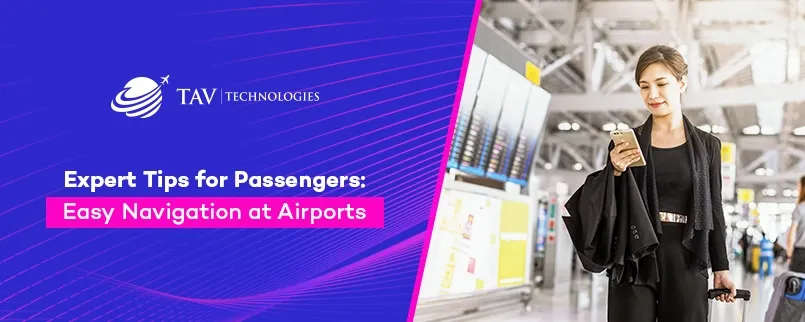
Apr 2023
Navigating through an airport can be a challenging experience for many passengers. With the complexity of airport layouts and numerous terminals, gates, and concourses, finding your way around is not easy. However, planning and preparation can make navigating through an airport less stressful.
Here is the list for a better journey at airports:
- Research the airport layout beforehand: Become familiar with the terminal and gate locations. Most airports have maps available on their websites or mobile apps, which can be very helpful in planning your route and locating amenities such as restrooms, dining options, and retail stores. Conducting pre-research can be valuable for passengers looking to park their car or get dropped off at the nearest location to their destination terminal. By doing so, you can save time and potentially avoid unnecessary walking or confusion
- Follow the signage: Once you arrive at the airport, follow the signage to your designated terminal or gate.
- Ask for help: If you have trouble finding your way or have any questions, do not hesitate to ask for help. Airport staff members are usually available and willing to assist travelers with questions or concerns.
- Use technology: With digital wayfinding solutions like info kiosks and mobile apps, navigation has become much more manageable. Digital tools can provide real-time updates on gate changes, flight delays, and baggage claim locations. Some airports even have interactive maps that can guide you through the airport and show you the location of various amenities. Flight Information Display systems are also beneficial to show significant details about each flight with boards and screens located at the airport.
Digitalization for Navigation and Wayfinding at Airports
Digitalization has significantly transformed the way we navigate airports. Technological advancements have made airport navigation more seamless, efficient, and hassle-free. In every aspect of our lives, technology has helped us simplify our daily tasks, and airport navigation is no exception.
The Convenience of Info Kiosks
Digital wayfinding solutions offer a multitude of benefits for passengers. Info kiosks, for example, provide interactive maps and directions to help passengers find their way around the airport. These kiosks are typically located at critical points throughout the airport and offer information on everything from gate locations to dining options.
They can also provide real-time updates on flight schedules, delays, and gate changes, which is especially important for passengers in a hurry.
The Popularity of Mobile Apps for Wayfinding
Similarly, mobile apps have become an increasingly popular wayfinding solution for travelers. These apps offer the convenience of having all the information you need at your fingertips, including terminal maps, gate locations, and airport amenities. Some apps even allow passengers to check in for their flight, track their baggage, and receive real-time notifications on flight changes.
Additionally, digitalization has made airport navigation more accessible and inclusive. With the introduction of assistive technologies and digital wayfinding systems, airports can now support passengers with disabilities and special needs. Passengers can also access real-time flight information and directions through mobile apps and other digital platforms, enabling them to navigate airports independently.
Digital wayfinding solutions benefit passengers and provide numerous advantages for airport operators. These solutions can help reduce congestion and improve flow within the airport, ultimately leading to a better travel experience for all passengers.
Modern Solutions for Smart Airports: TAV Technologies' Digital Services Make a Difference
TAV Technologies has recognized the importance of modern technological solutions in enhancing the passenger experience at airports. By offering a range of digital services like TAV Mobile and Info Kiosk, TAV Technologies has enabled airports to improve navigation for passengers, increase their engagement, and reduce the cost of employee services.
Using their device's camera, passengers can quickly scan their surroundings and access a helpful augmented reality mode that displays various points of interest throughout the terminal, such as shops, cafes, restaurants, and gates. This mode of TAV Mobile also provides the distance between the user's current location and the gate they need to reach, as well as ratings from other users for the stores and outlets. In addition, the augmented reality function enables passengers to obtain directions to their gates by holding up their phones. This streamlined feature eliminates the hassle of navigating a complex airport layout and allows travelers to reach their destination without problems.
Moreover, FIDS is one of the major systems that can be implemented at airports. Flight Information Display System is a cutting-edge digital signage solution that streamlines the distribution and display of real-time flight information to passengers and airport staff. The system is designed to automatically display up-to-date information on the appropriate screens at the right times, ensuring everyone can access the most current flight data and gate info.
By incorporating modern digital solutions, TAV Technologies has also helped airports reduce the cost of employee services. By automating processes and enabling self-service options, airports can minimize the need for staff members to handle routine tasks, thus freeing them up to focus on other important areas.
